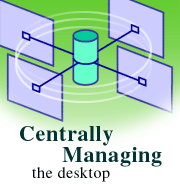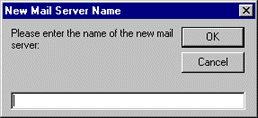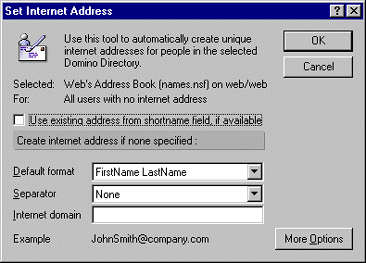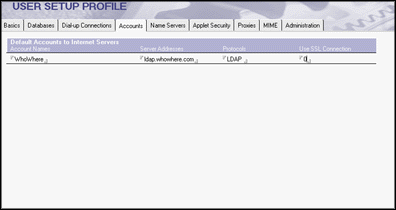 |

by
Susan
Florio
Barber

 

Level: Intermediate
Works with: Domino 5.0
Updated: 10/01/1999

Inside this article:
Moving mail files
Changing Internet addresses
Modifying Location documents
Adding bookmarks and replica stubs
Managing Internet accounts

Related links:
Up-to-Date with the Domino R5 Administration Process
Domino R5: Domain Search
Domino Administration Help
Art Thomas: Domino R5 Administration

Get the PDF:
 (180 KB) (180 KB)


|  |
If you are a Domino system administrator, you probably get a lot of calls from users who say, "I can't get to my mail," or "This application must be broken because I can't open it." Chances are, you respond with a standard series of questions and try to find out:
- Is the user connecting to the network?
- Is the user connecting to the server?
- Is the database pointing to the correct server?
These are basic, necessary questions, but as you all know, they are time-consuming. Domino R5 helps you to use your time more efficiently by allowing you to centrally manage the desktops of users in your organization. From your own desk, you can use the Domino Administrator to manage configurations. This is possible through new features collectively known as dynamic client configuration.
This article starts by giving you the details on how you can save time by centrally managing the desktops of users in your organization. It then describes how you can use R5 servers and clients, the Administration Process, Person documents, and User Setup Profiles to centrally manage the desktops of new and existing users.
Introducing dynamic client configuration
The components you can manage are:
- Location documents
- Connection documents
- Bookmarks
- Replicas
- Account documents
- The Mobile Directory
We'll show you how you can:
- Move a mail file
- Change an Internet address
- Use a user setup profile to make location document modifications and add fields of your own design to the User Setup Profile
- Add bookmarks and new replica stubs, including one for the mobile directory
- Add new Internet server account information
- Use multiple User Setup Profiles for users sharing computers
Note: In order to use the dynamic client configuration capabilities in R5, users must use the Notes R5 client and their home mail server must be an R5 server.
Time-saving aspects
The first way that centrally managing the desktop saves you time is by allowing you to push Bookmarks and Location documents, which control some of the elements that cause the problems in the questions in the introduction, directly to a user's desktop. Hopefully, this means that they won't need to call you in the first place, but even if they do you won't need to ask them all the basic questions. You can assume they are set up correctly and start asking some of the more complex questions right away.
Second, you are more likely to save time because you can debug, or at least ascertain the scope of the problem, without leaving your desk. You probably normally have to get up and go to the desktop of a user to fix a problem. Now, there are more instances where you will be able to fix the problem by adding a new bookmark or setting to the user's desktop. You can do this right at your desk in the Domino Administrator client.
Lastly, you can now set up client configurations easily using user setup profiles. This eliminates the need for individuals at remote offices to set up desktops customized to fit their own needs and saves you the time of sending the remote office a long e-mail with instructions on how to set it up. From one central location, you can control the look-and-feel of a group of Notes clients. This means that, for example, your entire sales organization can have the same set of bookmarks, pointing to sales related databases and Web sites. Domino R5 saves you time, and anything that saves you time saves your organization money.
Making moving mail files easy
Moving a mail file is common when you begin to run out of space on a server. In R5 moving a mail file is easier because dynamic client configuration takes over one of the steps that used to be manual. It changes the user's Location document to point to the new mail file. In R4.x you had to go to the user's desktop to change the Location document. Now the dynamic client configuration task updates Location documents and adds Connection documents to a client's Personal Address Book to reflect a mail file move.
When you decide you need to move a mail file, be aware that you cannot move a mail file to a different domain. Also, both the old mail server and the new mail server must be R5 servers and you'll need a Connection document between the old mail server and the new one.
There are some security issues that you need to check on before you move a mail file. Make sure that you have access to create a new replica on the new mail server. Then, make sure you have editor access to the Domino Directory on the new mail server, or author access with a UserModifier role. Both the old mail server and the new mail server will be managers of the mail file. To move a mail file:
- Open Domino Administrator.
- Select the bookmark for the server on which you want to make the change.
- Click the People & Groups tab.
- Click People.
- Select the person(s) whose mail file you want to move.
- Click the Move Mail File action.
- Click Yes at the prompt to move the mail file.
- Enter the new mail server name and click OK.

After you follow the steps above to move a user's mail file, the Administration Process gets involved. The Administration Process is a program that automates many routine administrative tasks. The Administration Process automates the process of moving mail files. For more in-depth information about the Administration Process and moving mail files, see Up-to-Date with the Domino R5 Administration Process. First, the Administration Process creates the new mail file on the new mail server. Next, it edits the user's Person document in the Domino Directory to reflect the new mail fields. The new mail fields replicate throughout the domain.
Now, the next time the user authenticates with their home mail server, dynamic client configuration adds a Notes Dialup Connection record to the new mail server and updates the Location documents. It replaces the names of the old mail server and the old mail file with the names of the new mail server and new mail file.
The only Location documents that are updated are those with a " * " or the person's name in the field "Only for user." Location documents designated as not to be remotely administered are not updated. In Release 5.01, Location documents designating an ID file in the field "User ID to switch to" different than the ID file currently being used are not updated. Any Location document that the dynamic client configuration task does not update, you must update manually.
Lastly, the two mail files replicate one last time and the old mail file is deleted. Before the old mail file is deleted, Domino Administrator prompts you whether or not you want to delete the old mail file.
Changing Internet addresses
You can also now change Internet addresses centrally. Changing an Internet address is common when someone in your organization changes their name, or when one organization buys another organization and you now want all the employees of the combined organization to have the same Internet address. To change Internet addresses you use a tool called the Internet Address tool located in Domino Administrator. This tool then changes the Internet Address field on the Basics tab of all the selected Person Documents in the Domino Directory. To change an Internet address:
- In Domino Administrator, select the bookmark for the server on which you want to make the change.
- Click the People & Groups tab.
- Click People.
- Expand the Tools menu on the right side of the screen.
- Under People, click Set Internet Address.
- In the Set Internet Address dialog box, choose a format for the Internet address you want to change.

- Choose a separator for the Internet address. This character separates the items in the Format field.
- Enter the Internet domain for the company.
- Click OK.
Now the Administration Process gets involved, as it does when you move a mail file. It checks all Person documents in the Domino Directory. When it finds a document without an entry in the Internet Address field of the Basics tab, it:
- Creates an entry based on the rules you specified in the Set Internet Address dialog box.
- Verifies that the entry is a valid RFC 821 address.
- Checks to ensure that the entry is unique by performing an exhaustive name lookup of the entry on all Domino Directories on the server. If the entry matches an Internet Address field, it leaves the field blank and enters an error in the Log (LOG.NSF). If not, then the next time the user authenticates, it pushes the new Internet address to the Location documents on the client.
Using the User Setup Profile to make Location document modifications
There are many different modifications you can make to a user's Location document using dynamic client configuration. You make these modifications using a User Setup Profile. Typically, you use a User Setup Profile to set up new Notes users. When you register users, you associate them with a specific profile so they receive a specific group of settings. You may want to create multiple profiles in your organization, each one tailored to a particular group of users. For example, you can create one profile to use when registering people in the sales department and another for people who work in a remote office.
Now, in addition to using the profile to set up new users, you can use a User Setup Profile to update the Notes client settings of existing users. You can specify User Setup Profiles for existing users in the Administration tab of their Person document, and you can associate one person with multiple user setup profiles.
Users receive the updates to the profile when they authenticate with the home server specified in their current Location document. The client caches user profiles each time their configuration changes, then when they authenticate, it compares the cached profile with the profile on the server. If the server profile has changed, the changes push down.
You can only add and modify settings using the profile; you cannot delete settings from a profile and then impose the deletions on an existing user. Also, users can prevent User Setup Profile modifications to their Location document by opening it in edit mode, choosing Actions - Advanced, and setting the Set Update Flag to No.
The Location document modifications that you can make using a User Setup Profile include changing the:
- Browser
- Passthru server
- Secondary name server information
- Proxy server
- Java applet security
- Domain Catalog search server
To modify the User Setup Profile:
- In Domino Administrator, choose the bookmark for the server on which you want to modify the User Setup Profile.
- Click the People & Groups tab.
- Select Domino Directories.
- Click Setup Profiles.
- Select the profile.
- Click Edit Setup Profile and make any modifications. The Internet Browser field and the Catalog/Domain Search field appear on the Basics tab and allow you to modify a user's default browser or Domain Search server. For more information about searching in R5, see Domino R5: Domain Search. The Dial-up Connections tab contains the default passthru server. The Name Servers tab contains secondary name server information. The Proxies tab contains information about your proxy servers and the Applet Security tab contains information about Java applet security.

- Click Save and Close.
When you use a User Setup Profile to change server connections, Domino automatically pushes new and modified Connection documents to the client.
You can also add fields of your own design to a User Setup Profile. As long as you also add the same field to the Location document, you can push various types of information to the client. For example, you may want to add an interval to the replication schedule in Location documents. Sometimes mobile users will set the replication schedule for their mail file to every minute. You may want to prevent this because of the heavy toll it takes on your server. Adding an interval field can solve this problem.
Adding bookmarks, replica stubs, and mobile directories
In R5 bookmarks replace database icons as database links. You can now push database links, or bookmarks, to users. You can use the Databases tab of the User Setup Profile to add bookmarks to a user's Notes client. The databases appear in the client's "Databases" bookmark folder. This allows you to push, for example, a link to a new human resources application to everyone in your organization.
To add bookmarks to a User Setup Profile:
- In the Notes client or Domino Administrator, open the database to which you want to provide a bookmark.
- Choose Edit - Copy As Link - Database Link.
- Open Domino Administrator.
- Choose the bookmark for the server on which you want to modify the User Setup Profile.
- Click the People & Groups tab.
- Select Domino Directories.
- Click Setup Profiles.
- Select the profile.
- Click Edit Setup Profile.
- Click the Databases tab.
- With your cursor in the "Default databases added to bookmarks" field, choose Edit - Paste. A link to the database appears in the field.

- Click Save and Close.
You can use the same steps to add new replica stubs and mobile directory catalogs. Domino pushes the new replica stub to the client. When you change the mobile directory, Domino pushes a new replica stub of the mobile directory to the client and modifies the Notes preferences of all the users for which you apply the User Setup Profile. Now, if someone in the sales department wants to reference a database of sales leads while they are on the road, you can create a replica stub of the database and push it the person's desktop.
Internet server account information
You can use the Accounts tab of the User Setup Profile to enter the account names, server addresses, protocols, and SSL connections to Internet servers that users need to access -- such as POP, SMTP, or IMAP mail, NNTP newsgroups, or LDAP directories. For example, you can create an LDAP account for WhoWhere so that it appears in the list of searchable directories available in the "Look in" field of the Select Addresses dialog box when you address mail. Enter WhoWhere in the Account Names field, ldap.whowhere.com in the Server Addresses field, LDAP in the Protocols field, and 0 (for no SSL required) in the Use SSL Connection field. Note that you can enter several values in each field if you want to create multiple Internet accounts for each user.

Domino pushes the new or modified Internet server account information into Account documents in the user's Personal Address Book.
Using multiple User Setup Profiles and sharing computers
You can use multiple User Setup Profiles within your organization. The profiles are additive, meaning that when you use a profile to add information to a user's Notes client, it doesn't therefore remove any existing information, such as bookmarks. However, it will remove certain information if you replace that information with something new. For example, a proxy setting pushed down with one User Setup Profile will replace a proxy setting pushed down by an earlier User Setup Profile because the proxy field does not allow multiple entries.
If you use two different profiles to add information to a user's Notes client, the profiles execute in alphabetical order, so a profile called "Acme" executes before a profile called "Sales". This means you can use the Acme User Setup Profile, containing Human Resources Bookmarks, Proxy1, and the Acme Mobile Directory for your entire organization; and the Sales profile, containing Sales leads Bookmarks and the SalesProxy only for those users in the sales organization. The result of this is that the settings in the Sales profile overwrite some of the settings in the Acme profile. Users in the sales organization will have Human Resources Bookmarks, Sales lead Bookmarks, the SalesProxy, and the ACME Mobile Directory.
Sharing a computer means that the two people using the computer use the same address book. In this situation, you won't want to push the same changes to both people. In the Location document, you can specify that a certain location belongs to a certain user. If you associate user A with location A and user B with location B. Then you can push down changes to locations that only user A owns.
Conclusion
This article demonstrates several ways you can manage users' desktops without actually visiting their desks. You can spend the time you save checking out Domino Administration Help for full details about using these and many other time-saving Domino Administrator tools. |